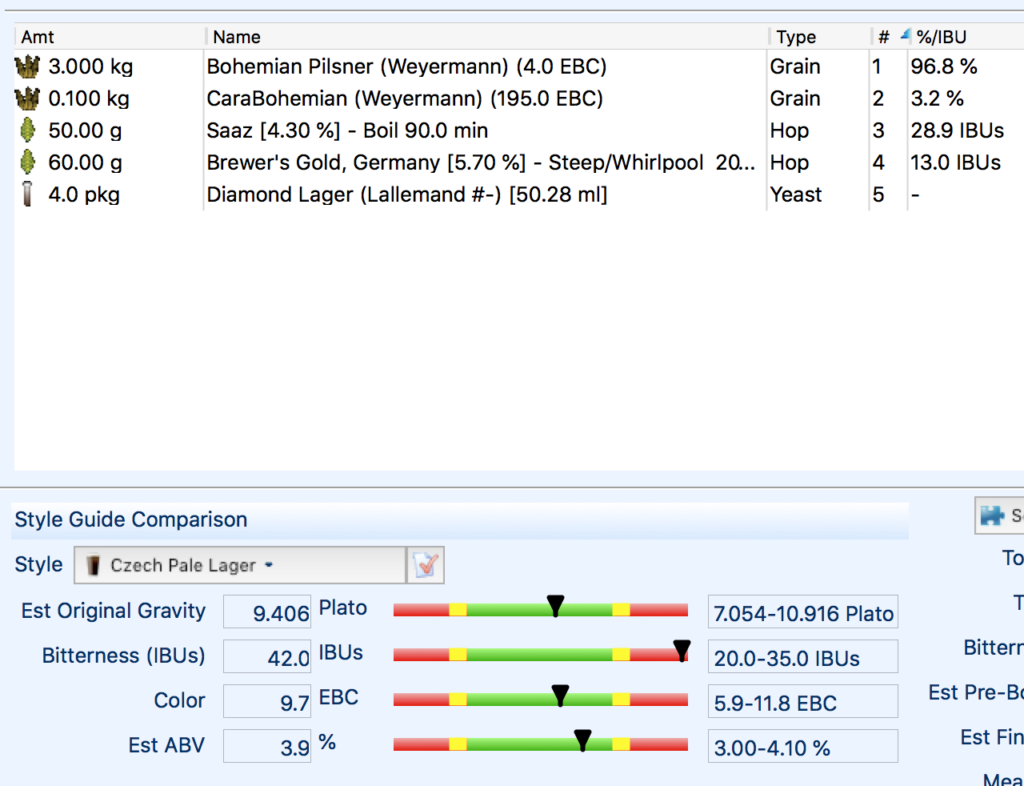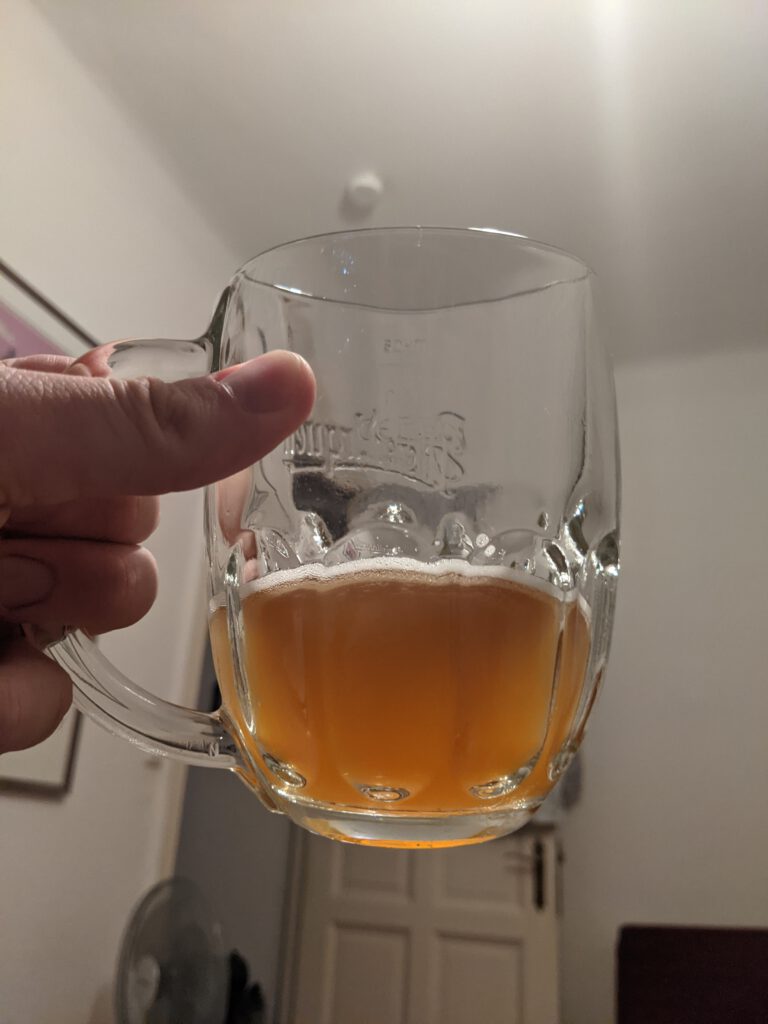Due to a rather bad episode of COVID, I hadn’t brewed a beer since October 2020, a Helles, which, when I bottled it in April this year, didn’t properly bottle-condition, and instead became an oxidized mess.
So this beer was a fresh start, my first home-brewed beer in a long time, and just something I wanted to have for myself. When I developed that recipe, I got inspired by two things:
First, the Czech Republic’s culture for lower-alcohol beers, with original gravities of 10°P or lower, and moderate amounts of alcohol of 4% ABV and lower.
Second, a particular Leichtbier that I had at Mahrs Bräu in Bamberg, which they call Sommerpils: it’s a very bitter beer at only 2.8% ABV and 7.2°P OG, and the first time I realized that highly hopped beers with low ABV can work really well.
After some thinking, I came up with an idea: I wanted to create a Czech-inspired 8° beer, with a good amount of bitterness coming from a late hop addition at flameout. One particular hop variety that I really liked in the past was Brewers Gold. I had used it in a Golden Ale previously, and it just gave off lovely citrusy notes with a fruitiness that some describe as blackcurrant.
But why would I call it Czech-inspired? First of all, the OG: 8°P is something that you would in the Czech Republic more often that in e.g. Germany. German Leichtbiere are typically even lower than that.
Second, the grist: I decided to stick to just Bohemian Pilsner malt and a small ~3% addition of a dark caramel malt, in my case CaraBohemian.
Third, the mashing regime: I’m a huge fan of double decoction. Even though it takes a long time, it has given me very good results in previous beers. In particular, I’m using an enhanced double decoction scheme that basically skips protein rest or keeps it to a very short amount time. Decoction mashing is also extremely common in Czech brewing.
Fourth, the bittering hops: I used Saaz hops simply because I had them available, they’re reliable and suitable for what I wanted to achieve. As aroma hops, as mentioned above, I got Hallertau-grown Brewers Gold.
Let’s quickly compare this to the PGI regulation for the term “Czech Beer”: at least 80% of the sugar in the wort needs to be from malt from Czech barley varieties (which I assume Weyermann’s Bohemian Pilsner malt should fulfill), at least 30% of alpha acids from hops must come from Czech hop varieties (I’m using Saaz for bittering), local water must be used (I do that), bottom-fermenting yeast must be used, and decoction mashing must be used. I’d say I’m pretty close, except I don’t brew in the Czech Republic, nor do I attempt to get any PGI Czech Beer certification for my home-brewed beer. Nevertheless, the regulation is still a good indicator of what’s considered to be traditional or necessary for Czech beer, and therefore also serves as a good template for Czech-style or Czech-inspired beers.
The brew day itself was relatively uneventful, except for a slightly higher than expected OG of 9.4°P. The 8° beer became a 9° beer. I can cope with that.
I chilled the wort, pitched plenty of Lallemand Diamond Lager yeast, and just let it ferment. When the beer was fully attenuated, I decided not to bother with lengthy lagering, but instead just slowly lowered the temperature down to -1°C, kept it there for a few days, and then bottled the beer.
My Czech-inspired beer is now bottle-conditioned and ready to be consumed. When I first poured it, I was surprised about how hazy it was. Even after several more days in the fridge, it still remains hazy. I blame hop haze from the flame-out addition, but to be honest, I don’t actually care. Because the beer itself tastes great.
It’s got a full body, at a FG of 2.2°P, and with 3.9%ABV, it’s a very drinkable beer with a robust bitterness that lingers on. The Brewers Gold hops provide a nice citrusy flavour, but its additional fruitiness in the aroma combined with a slightly lower than expected carbonation (my fault) gives the beer an English Bitter vibe. Brewers Gold was originally an English hop variety, and it still shows in this bottom-fermented beer.
All in all, I’m really happy with the result. It’s a nice, refreshing beer perfect for a hot summer. I still have ~17 litres in my fridge that likely won’t last till the end of summer.
And finally, a photo of what the beer actually looks like. An alternative title for this blog post that I had in mind earlier was “my crispy boi is also a hazy boi”.



Congratulations on your first beer after the difficult episode Andreas! I hope everything is ok with your health.
These low abv Czech beers are really awesome. I need to rebrew one but with decoction this time.
I don’t know if you use Diamond Lager yeast often, but once I fermented the same wort with Diamond and W-34/70 (dry) and the former was more cloudy.
I haven’t had issues with cloudiness with the Diamond Lager yeast so far, but I suspect there may have been another issue, as fermentation took ages to finish. Maybe a mistake on my end when I rehydrated the dry yeast? Maybe just chill haze? No idea. 🙂
Love the czech beer styles as well and brewing double decoction. I sssume you used the Weyermann czech malts. In my czech brews there always remains a haziness. For me, it’s part of the style now. The haze drops the longer the beer stays in the keg.